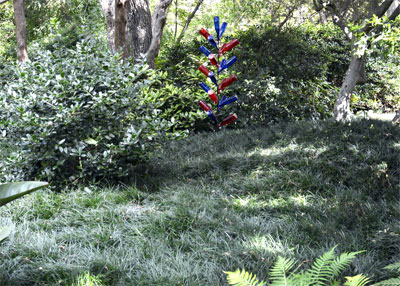From the Sperry Gardens

The lady who called me earlier this week wanted to talk about once-a-week watering for a Texas newspaper group. I thought it was a little late to be asking that, but then I decided she might just have moved here from out-of-state. So I ventured on. (You learn when you work in the media, to be careful what you say when you’re being interviewed. Misquotes are common, and it’s impossible to correct them once they have printed.)
She seemed very attuned to gardening, and she asked insightful questions, so I relaxed and outlined a few things that have helped me get through in our own landscape over the past several years of dry spells. Here’s a synopsis of what I suggested.
• Start with adapted plants. That is, plants that are suited to your part of Texas. It really doesn’t matter whether those plants are native to Texas or not. It’s much more important that they will thrive in your gardens.
• Fall (October/November) is the best time for planting. It gives the new plants the maximum time to establish new roots before summer returns.
• Hand-water plants every couple of days the first summer or two after planting. Sprinkler irrigation alone won’t be enough, especially when you’re on strict watering curtailments.
• Eliminate all weeds and unwanted plants that rob the soil of available moisture. Weeds use far more water than most of our landscaping plants.
• Mulch beds to reduce soil-to-air contact. Mulches make very great differences in speed with which soils dry out. Organic mulches (bark, compost, shredded tree leaves, etc.) have several benefits over gravel, rubber and other inorganic mulches.
• Do not apply nitrogen fertilizer during the hottest times of the summer. Fall feedings are the most important of the entire growing season.
Note that raising the lawn mower blade does not conserve moisture as some will have you believe. It’s better to keep mowing at the recommended height (for the type of grass that you’re growing) 12 months a year.
Finally, “smart” controllers conserve a great deal of water when they’re installed by a professional and kept in good working order. They take into consideration factors like plant species, soil type, sun/shade, slope, type of sprinkler heads, temperature, wind and recent weather to determine when the sprinkler system should run, also for how long each station will irrigate. Typical savings with these modern controllers is 30 to 50 percent of prior consumption.
As for the bottle tree, if you look closely you can see the evil spirits that are trapped up inside the bottles. Keep zooming in until you see them. I’m just sure that you will if you try hard enough. Thanks to my bottle tree, I feel safer than ever out in my garden. More on that another time here.
